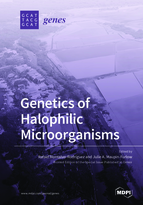Genetics of Halophilic Microorganisms
A special issue of Genes (ISSN 2073-4425). This special issue belongs to the section "Microbial Genetics and Genomics".
Deadline for manuscript submissions: closed (28 February 2019) | Viewed by 55463
Special Issue Editors
Interests: microbiology; microbial physiology and genetics; taxonomy; microbial life in extreme environments; metagenomics
Special Issues, Collections and Topics in MDPI journals
Interests: archaea; oxidative stress; redox control; post-translational modification; proteostasis; proteolysis; ubiquitin-like proteasome systems; metabolism; hypersaline; halophiles
Special Issues, Collections and Topics in MDPI journals
Special Issue Information
Dear Colleagues,
Halophilic microorganisms can be found in all domains of life and can thrive in environments with high salt content. They have been a subject of study for many years due to their interesting properties and physiology. An understanding of the genetics of halophilic microorganisms (from gene expression and regulation to genomics) will help to better understand the mechanisms of how life can occur at high salinity levels. This Special Issue is dedicated to the Genetics of Halophilic Microorganisms and their viruses. Colleagues are cordially invited to contribute original research papers or reviews to this Special Issue.
Prof. Rafael Montalvo-Rodríguez
Prof. Julie A. Maupin-Furlow
Guest Editors
Manuscript Submission Information
Manuscripts should be submitted online at www.mdpi.com by registering and logging in to this website. Once you are registered, click here to go to the submission form. Manuscripts can be submitted until the deadline. All submissions that pass pre-check are peer-reviewed. Accepted papers will be published continuously in the journal (as soon as accepted) and will be listed together on the special issue website. Research articles, review articles as well as short communications are invited. For planned papers, a title and short abstract (about 100 words) can be sent to the Editorial Office for announcement on this website.
Submitted manuscripts should not have been published previously, nor be under consideration for publication elsewhere (except conference proceedings papers). All manuscripts are thoroughly refereed through a single-blind peer-review process. A guide for authors and other relevant information for submission of manuscripts is available on the Instructions for Authors page. Genes is an international peer-reviewed open access monthly journal published by MDPI.
Please visit the Instructions for Authors page before submitting a manuscript. The Article Processing Charge (APC) for publication in this open access journal is 2600 CHF (Swiss Francs). Submitted papers should be well formatted and use good English. Authors may use MDPI's English editing service prior to publication or during author revisions.
Keywords
- Halophilic microorganisms
- Genetics
- Genomics
- Molecular Evolution
- Hypersaline habitats
- Extremophiles








